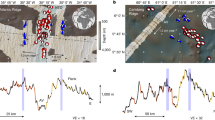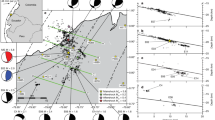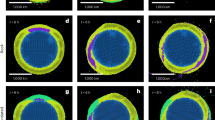Abstract
A deep-seated melt or fluid layer on top of the 410-km-deep seismic discontinuity in Earth’s upper mantle, as proposed in the transition-zone ‘water filter’ hypothesis1, may have significant bearing on mantle dynamics and chemical differentiation. The geophysical detection of such a layer has, however, proved difficult. Magnetotelluric and geomagnetic depth sounding are geophysical methods sensitive to mantle melt. Here we use these methods to search for a distinct structure near 410-km depth. We calculate one-dimensional forward models of the response of electrical conductivity depth profiles, based on mineral physics studies of the effect of incorporating hydrogen in upper-mantle and transition-zone minerals. These models indicate that a melt layer at 410-km depth is consistent with regional magnetotelluric and geomagnetic depth sounding data from the southwestern United States (Tucson)2. The 410-km-deep melt layer in this model has a conductance of 3.0 × 104 S and an estimated thickness of 5–30 km. This is the only regional data set that we have examined for which such a melt layer structure was found, consistent with regional seismic studies3. We infer that the hypothesized transition-zone water filter1 occurs regionally, but that such a layer is unlikely to be a global feature.
This is a preview of subscription content, access via your institution
Access options
Subscribe to this journal
Receive 51 print issues and online access
$199.00 per year
only $3.90 per issue
Buy this article
- Purchase on Springer Link
- Instant access to full article PDF
Prices may be subject to local taxes which are calculated during checkout



Similar content being viewed by others
References
Bercovici, D. & Karato, S. Whole-mantle convection and the transition-zone water filter. Nature 425, 39–44 (2003)
Egbert, G. D., Booker, J. R. & Schultz, A. Very long period magnetotellurics at Tucson Observatory: Estimation of impedances. J. Geophys. Res. B 97, 15113–15128 (1992)
Song, T. R. A., Helmberger, D. V. & Grand, S. P. Low-velocity zone atop the 410-km seismic discontinuity in the northwestern United States. Nature 427, 530–533 (2004)
Revenaugh, J. & Sipkin, S. A. Seismic evidence for silicate melt atop the 410-km mantle discontinuity. Nature 369, 474–476 (1994)
Wang, D., Mookherjee, M., Xu, Y. S. & Karato, S. The effect of hydrogen on the electrical conductivity in olivine. Nature 443, 977–980 (2006)
Huang, X. G., Xu, Y. S. & Karato, S. I. Water content in the transition zone from electrical conductivity of wadsleyite and ringwoodite. Nature 434, 746–749 (2005)
Gaillard, F. Laboratory measurements of electrical conductivity of hydrous and dry silicic melts under pressure. Earth Planet. Sci. Lett. 218, 215–228 (2004)
Tyburczy, J. A. & Fisler, D. K. in Mineral Physics and Crystallography: A Handbook of Physical Constants (ed. Ahrens, T. J.) 185–208 (American Geophysical Union, Washington DC, 1995)
Tyburczy, J. A. & Waff, H. S. Electrical conductivity of molten basalt and andesite to 25 kilobars pressure — Geophysical significance and implications for charge transport and melt structure. J. Geophys. Res. 88, 2413–2430 (1983)
Tarits, P., Hautot, S. & Perrier, F. Water in the mantle: Results from electrical conductivity beneath the French Alps. Geophys. Res. Lett. 31 L06612 doi: 10.1029/2003GL019227 (2004)
Lizarralde, D., Chave, A., Hirth, G. & Schultz, A. Northeastern Pacific mantle conductivity profile from long-period magnetotelluric sounding using Hawaii-to-California submarine cable data. J. Geophys. Res. B 100, 17837–17854 (1995)
Olsen, N. Long-period (30 days-1 year) electromagnetic sounding and the electrical conductivity of the lower mantle beneath Europe. Geophys. J. Int. 138, 179–187 (1999)
Schultz, A., Kurtz, R. D., Chave, A. D. & Jones, A. G. Conductivity discontinuities in the upper mantle beneath a stable craton. Geophys. Res. Lett. 20, 2941–2944 (1993)
Xu, Y. S., Shankland, T. J. & Poe, B. T. Laboratory-based electrical conductivity in the Earth’s mantle. J. Geophys. Res. B 105, 27865–27875 (2000)
Simpson, F. Resistance to mantle flow inferred from electromagnetic strike of the Australian upper mantle. Nature 412, 632–635 (2001)
Brown, J. M. & Shankland, T. J. Thermodynamic parameters in the Earth as determined from seismic profiles. Geophys. J. R. Astron. Soc. 66, 579–596 (1981)
Mitchell, A. C. & Nellis, W. J. Equation of state and electrical conductivity of water and ammonia shocked to 100 GPa (1Mbar) pressure range. J. Chem. Phys. 76, 6273–6281 (1982)
Ohtani, E. & Maeda, M. Density of basaltic melt at high pressure and stability of the melt at the base of the lower mantle. Earth Planet. Sci. Lett. 193, 69–75 (2001)
Ohtani, E., Nagata, Y., Suzuki, A. & Kato, T. Melting relations of peridotite and the density crossover in planetary mantles. Chem. Geol. 120, 207–221 (1995)
Suzuki, A., Ohtani, E. & Kato, T. Density and thermal expansion of a peridotite melt at high pressure. Phys. Earth Planet. Inter. 107, 53–61 (1998)
Matsukage, K. N., Jing, Z. C. & Karato, S. Density of hydrous silicate melt at the conditions of Earth’s deep upper mantle. Nature 438, 488–491 (2005)
Sakamaki, T., Suzuki, A. & Ohtani, E. Stability of hydrous melt at the base of the Earth’s upper mantle. Nature 439, 192–194 (2006)
Kohlstedt, D. L., Keppler, H. & Rubie, D. C. Solubility of water in the α, β and γ phases of (Mg,Fe)2SiO4 . Contrib. Mineral. Petrol. 123, 345–357 (1996)
Bell, D. R., Rossman, G. R., Maldener, J., Endisch, D. & Rauch, F. Hydroxide in olivine: A quantitative determination of the absolute amount and calibration of the IR spectrum. J. Geophys. Res. 108 B2105 doi: 10.1029/2001JB000679 (2003)
Hirschmann, M. M., Aubaud, C. & Withers, A. C. Storage capacity of H2O in nominally anhydrous minerals in the upper mantle. Earth Planet. Sci. Lett. 236, 167–181 (2005)
van der Lee, S. & Nolet, G. Upper mantle S velocity structure of North America. J. Geophys. Res. B 102, 22815–22838 (1997)
Parker, R. L. The inverse problem of electromagnetic induction — Existence and construction of solutions based on incomplete data. J. Geophys. Res. 85, 4421–4428 (1980)
Acknowledgements
We thank S. Constable and E. Garnero for comments and discussion. This work was supported by the National Science Foundation.
Author information
Authors and Affiliations
Corresponding author
Ethics declarations
Competing interests
Reprints and permissions information is available at www.nature.com/reprints. The authors declare no competing financial interests.
Supplementary information
Supplementary Information
This file contains Supplementary Discussion with Supplementary Figure S1 with Legend. (PDF 930 kb)
Rights and permissions
About this article
Cite this article
Toffelmier, D., Tyburczy, J. Electromagnetic detection of a 410-km-deep melt layer in the southwestern United States. Nature 447, 991–994 (2007). https://doi.org/10.1038/nature05922
Received:
Accepted:
Issue Date:
DOI: https://doi.org/10.1038/nature05922
This article is cited by
-
Insights into magma ocean dynamics from the transport properties of basaltic melt
Nature Communications (2022)
-
Behavior and properties of water in silicate melts under deep mantle conditions
Scientific Reports (2021)
-
Connection between earthquakes and deep fluids revealed by magnetotelluric imaging in Songyuan, China
Science China Earth Sciences (2021)
-
Deep origin of Cenozoic volcanoes in Northeast China revealed by 3-D electrical structure
Science China Earth Sciences (2020)
-
Hydrous magnesium-rich magma genesis at the top of the lower mantle
Scientific Reports (2019)
Comments
By submitting a comment you agree to abide by our Terms and Community Guidelines. If you find something abusive or that does not comply with our terms or guidelines please flag it as inappropriate.



